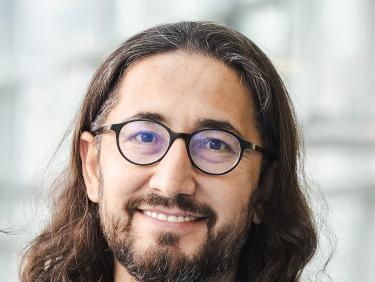Prof. Yasin Dagdas Evolutionary Cell Biology
Our long-term objective is to unravel the molecular mechanisms of cellular quality control that enable eukaryotic organisms to survive and thrive across diverse environments.
By unlocking these fundamental processes, we aspire to establish novel strategies to enhance stress tolerance in plant and human cells. To achieve our goal, we propose an integrative approach rooted in comparative cell biology. We aim to sample the extraordinary diversity embedded across the eukaryotic tree of life to discover new autophagy pathways. We then leverage a comprehensive suite of cutting-edge cell biological and biochemical tools to dissect these novel quality control pathways and their contribution to organismal homeostasis.
Historically, comparative methodologies have been the bedrock of transformative breakthroughs in molecular biology. Yet, recent trends have seen a narrowing focus on a handful of “model” organisms, leading to a decline in comparative studies within mechanistic research. Simultaneously, evolutionary biology has often concentrated on genes and proteins in isolation, overlooking the cell as the fundamental arena of evolutionary innovation. Our mission is to bridge this critical gap by establishing an evolutionary cell biology program dedicated to the molecular and functional evolution of the autophagy pathway.

Research Themes
1. Selective autophagy receptor discovery and characterization: We harness comparative cell biology to uncover novel selective autophagy receptors, and characterize them using cutting-edge mechanistic tools.
2. Endoplasmic reticulum homeostasis and UFMylation: Building on our discovery of the conserved autophagy receptor C53 and its regulation by the enigmatic UFMylation pathway, our research combines evolutionary cell biology, advanced RNA biochemistry, and omics to illuminate the hidden roles of UFMylation in maintaining cellular homeostasis.
3. ATG8ylation and Vacuolar Quality Control: Our recent discovery that cell wall damage induces ATG8ylation of the tonoplast—a process known as non-canonical autophagy—opens exciting questions about how this modification safeguards vacuolar health. We are now unraveling the intricate mechanisms and physiological significance of this pathway.
4. Cell-Type Specific Autophagy Mechanisms: Understanding how autophagy varies among distinct cell types is a major frontier in cellular quality control research. With innovative tools we've developed, we're investigating how specialized autophagy pathways coordinate to sustain overall organismal homeostasis in response to diverse stresses.
Join Us
We are currently recruiting at all levels! We are particularly interested in adding a structural biologist or biochemist to our team. If you are Interested, please reach out to
Selected Publications
Zhao J, Löfke C, Yeung KC, Chen Y, Dagdas Y. Cell-type specific autophagy in root hair forming cells is essential for salt stress tolerance in Arabidopsis thaliana. bioRxiv; 2025. doi: 10.1101/2025.03.18.643786. PPR:PPR991461.
Julian J, Gao P, Del Chiaro A, Carlos De La Concepcion J, Armengot L, Somssich M, Duverge H, Clavel M, Grujic N, Kobylinska R, Polivka I, Besten M, Andersen TG, Dank C, Korbei B, Bachmair A, Coll NS, Minina EA, Sprakel J, Dagdas Y. ATG8ylation of vacuolar membrane protects plants against cell wall damage. Nat Plants. 2025 Feb;11(2):321-339. doi: 10.1038/s41477-025-01907-z. PMID: 39920307; PMCID: PMC11842276.
Mihailovic M, Anisimova AS, Erte B, Zhan N, Styliara I, Dagdas Y, Karagöz GE. The coordinated action of UFMylation and ribosome-associated quality control pathway clears arrested nascent chains at the endoplasmic reticulum. bioRxiv; 2025. doi: 10.1101/2025.01.17.633636. PPR:PPR967680.
Del Chiaro A, Grujic N, Zhao J, Papareddy RK, Gao P, Ma J, Lofke C, Bhattacharya A, Gruetzner R, Bourguet P, Berger F, Kang B, Marillonnet S, Dagdas Y. Nonuple atg8 mutant provides genetic evidence for functional specialization of ATG8 isoforms in Arabidopsis thaliana. bioRxiv; 2024. doi: 10.1101/2024.12.10.627464. PPR:PPR952498.
Hernández VSdM, García MMN, Clavel M, Papareddy RK, Andreev VI, Mathur V, Mohseni A, García-León M, Gao P, de la Concepción JC, Picchianti L, Grujic N, Kobylinska R, Abdrakhmanov A, Duvergé H, Anand G, Leibrock N, Bianchi A, Raffeiner M, Crawford TS, Argirò L, Matuszkiewicz M, Wun C, Kanne JV, Meinhart A, Roitinger E, Bäurle I, Kang BH, Petersen M, Üstün S, Kulathu Y, Clausen T, Ramundo S, Dagdas Y. Cross-species interactome analysis uncovers a conserved selective autophagy mechanism for protein quality control in plants. bioRxiv; 2024. doi: 10.1101/2024.09.08.611708. PPR:PPR907787.
Clavel M, Bianchi A, Kobylinska R, Groh R, Ma J, Papareddy RK, Grujic N, Picchianti L, Stewart E, Schutzbier M, Stejskal K, de la Concepcion JC, de Medina Hernandez VS, Voichek Y, Clauw P, Gunis J, Durnberger G, Muelders JC, Grimm A, Sedivy A, Erhardt M, Vyboishchikov V, Gao P, Lechner E, Vantard E, Jez J, Roitinger E, Genschik P, Kang B, Dagdas Y. Metabolic enzymes moonlight as selective autophagy receptors to protect plants against viral-induced cellular damage. bioRxiv; 2024. doi: 10.1101/2024.05.06.590709. PPR:PPR849682.
Picchianti L, Sánchez de Medina Hernández V, Zhan N, Irwin NA, Groh R, Stephani M, Hornegger H, Beveridge R, Sawa-Makarska J, Lendl T, Grujic N, Naumann C, Martens S, Richards TA, Clausen T, Ramundo S, Karagöz GE, Dagdas Y. Shuffled ATG8 interacting motifs form an ancestral bridge between UFMylation and autophagy. EMBO J. 2023 May;42(10):e112053. doi: 10.15252/embj.2022112053. PMID: 36762703; PMCID: PMC10183829.
Zhao J, Bui MT, Ma J, Künzl F, Picchianti L, De La Concepcion JC, Chen Y, Petsangouraki S, Mohseni A, García-Leon M, Gomez MS, Giannini C, Gwennogan D, Kobylinska R, Clavel M, Schellmann S, Jaillais Y, Friml J, Kang BH, Dagdas Y. Plant autophagosomes mature into amphisomes prior to their delivery to the central vacuole. J Cell Biol. 2022 Dec;221(12):e202203139. doi: 10.1083/jcb.202203139. PMID: 36260289; PMCID: PMC9584626.
Stephani M, Picchianti L, Gajic A, Beveridge R, Skarwan E, Sanchez de Medina Hernandez V, Mohseni A, Clavel M, Zeng Y, Naumann C, Matuszkiewicz M, Turco E, Loefke C, Li B, Dürnberger G, Schutzbier M, Chen HT, Abdrakhmanov A, Savova A, Chia KS, Djamei A, Schaffner I, Abel S, Jiang L, Mechtler K, Ikeda F, Martens S, Clausen T, Dagdas Y. A cross-kingdom conserved ER-phagy receptor maintains endoplasmic reticulum homeostasis during stress. Elife. 2020 Aug;9:e58396. doi: 10.7554/elife.58396. PMID: 32851973; PMCID: PMC7515635.



